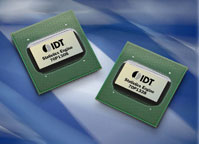Integrated Device Technology has rolled out what it claims is the industry’s first off-the-shelf statistics engine.
Targeting edge router, broadband access equipment and multi-service provisioning platforms, the IDT statistics engine features a Network Processor Forum (NPF) Look Aside (LA-1) interface and offloads processor elements such as NPUs, FPGAs and ASICs of the critical function of statistics tracking.
“Customers looking to design a 10G (OC-192) edge/access/metro router, coupled with a current generation packet processor, will experience difficulty achieving line rates when supporting thousands of customer flows. This equipment requires differentiated services, and maintaining quality of service and service-level agreements at line rates with a single processor design is nearly impossible.
By preventing the processor element from stalling on the restrictive external bus transactions, the IDT statistics engine will play a critical role in helping customers overcome system-performance challenges,” said Michael Miller, IDT chief technology officer and vice president of the Systems Technology Group.
Edge and access equipment must maintain counters for thousands of customer flows, which is beyond the on-chip storage of today’s NPUs and ASICs, thus requiring off-chip storage, according to the company.

With today’s internal processing elements operating in excess of 1 GHz, stalling on multiple external multi-clock read cycles per packet for flow statistics is very costly. Stalls often require processor threads to context switch, further adding to complexity and overhead, which can exceed design budgets.
The IDT statistics engine uses an integrated 64-bit arithmetic logic unit (ALU) designed to offload data-path processor cycles, typically resulting in a 90% improvement in network processor cycles required for statistics computation. This allows designers to increase the line rate of packet processing and execute deeper packet inspection to support new IP-based services.
The ALU coupled with a multi-port memory cell architecture enables the statistics engine to update multiple counters with an innovative, patent-pending “fire-and-forget” operation. “Fire and forget” is an atomic operation that replaces the conventional read-modify-write sequence, and allows the processor element to access and update as many as four counters on every clock cycle. The benefits associated with the “fire-and-forget” function include up to 87% improvement in QDR-II bandwidth. This feature will be especially useful to software designers who up until now, have relied on cycle consuming read-modify-write routines in their code.
The enhanced multi-port memory cell architecture of the IDT statistics engine also ensures coherency for low latency statistics operations that require multiple statistics updates every five nanoseconds, a capacity that becomes important at 10G and above line rates. The configurable 64/32-bit ALU is also useful for systems that need to upgrade their legacy 32-bit operations to 64-bit operations without incurring performance penalties.
These configurable options, offering customers either 512K 32-bit counters or 256K 64-bit counters, allow the on-chip memory resources to be partitioned to match the system applications, such as traffic engineering and billing.
In addition, the device’s ability to “clamshell” to x18 burst-of-two QDR-II SRAM lends itself to ease of board design while addressing the emerging trend towards standardization in network systems.
The IDT statistics engine is available in a 576-ball, RoHS-compliant flip-chip package. The product is currently sampling and is priced at $55.00 to $65.00 in 25,000 unit quantities.




Swiss geoengineering start-up targets methane removal
No mention whatsoever about the effect of increased methane levels/iron chloride in the ocean on the pH and chemical properties of the ocean - are we...